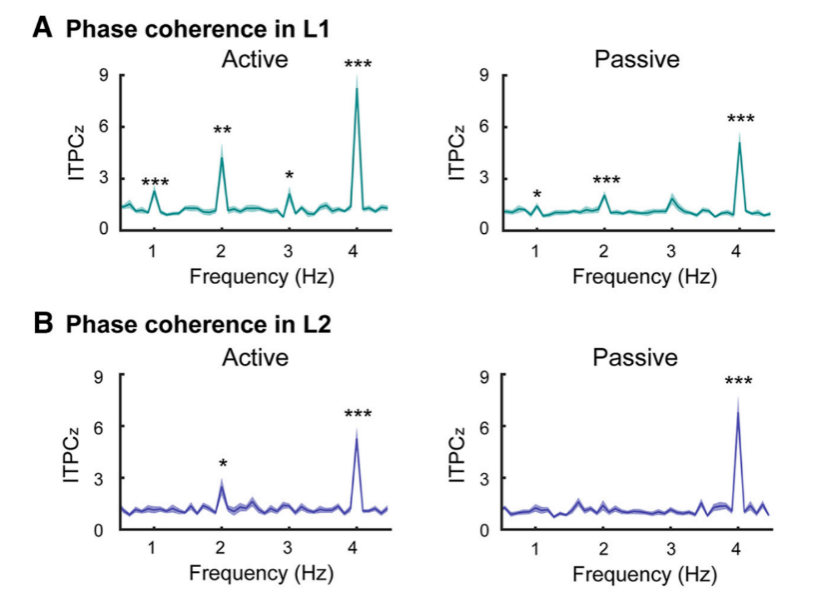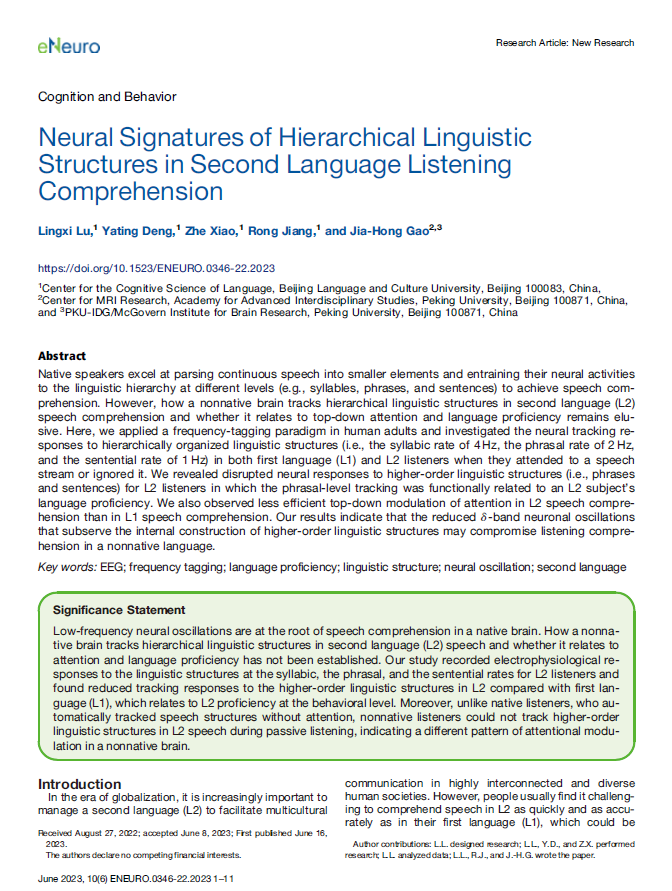In a recent publication in theeNeurojournal, titled "Neural signatures of hierarchical linguistic structures in second language listening comprehension," our base's full-time researchers, including Associate Researcher Lu Lingxi, have revealed the neural mechanisms behind language hierarchy processing in second language comprehension. This study was conducted under the umbrella of the Society of Neuroscience (SfN).

ImageImage Caption:Figure 1, A: Auditory speech stimuli containing three language hierarchy structures corresponding to frequencies of 4 Hz, 2 Hz, and 1 Hz. B: Speech stimulus spectrum. C: Schematic representation of active attention and passive attention experimental procedures.
In the process of comprehending one's native language, the brain swiftly dissects continuous speech streams into various linguistic units such as characters, words, phrases, and sentences, while dynamically tracking language hierarchy structures at different temporal scales. However, second language learners encounter a series of challenges when perceiving speech and comprehending language, and the underlying cognitive neural processing mechanisms remain unclear. To address this issue, the study recruited two groups of participants: native Mandarin Chinese speakers and Chinese Mandarin second language learners. Auditory speech stimuli, encompassing three language hierarchy structures (characters, words, and sentences), were employed as experimental materials. These structures were presented at fixed frequencies of 4 Hz, 2 Hz, and 1 Hz. The experiment included both active attention and passive attention conditions, with participants' neural activities while listening to speech stimuli recorded using electroencephalography (EEG) technology.

ImageImage Caption:Figure 2, Neural tracking activities of language hierarchy structures in native Mandarin speakers and Chinese Mandarin second language learners.
The study findings indicate that, compared to native Mandarin speakers, Chinese Mandarin second language learners exhibit significantly weaker neural tracking of higher-level language structures (words and sentences). Under active attention conditions, second language learners can only track character and word structures, whereas under passive attention conditions, they can only track character structures (i.e., speech envelopes). Furthermore, there exists a significant positive correlation between the neural representation of word structures and the language proficiency of second language learners. In other words, the higher the proficiency of second language learners in Mandarin Chinese, the stronger their ability at the neural level to construct higher-level language structures and perform rapid neural tracking. Additionally, second language learners demonstrate different attention modulation patterns from native Mandarin speakers when invoking attention resources to aid language comprehension. These research findings provide crucial empirical evidence for the neural mechanisms behind language hierarchy processing in second language auditory comprehension.

The first and corresponding author of the paper is Associate Researcher Lu Lingxi from Beijing Language University's Discipline Innovation and Intelligence Introduction Base for Language Cognitive Science. Co-authors of the paper include Professor Gao Jiahong from Peking University, Associate Professor Jiang Rong from Beijing Language University, and master's students Deng Yating and Xiao Zhe from the Beijing Language University's Intelligence Introduction Base. This research received support from the Beijing Social Science Foundation Youth Project.
Paper Reference:Lu, L.*, Deng, Y., Xiao, Z., Jiang, R., & Gao, J. H. (2023). Neural signatures of hierarchical linguistic structures in second language listening comprehension.eNeuro, 10(6).https://doi.org/10.1523/ENEURO.0346-22.2023